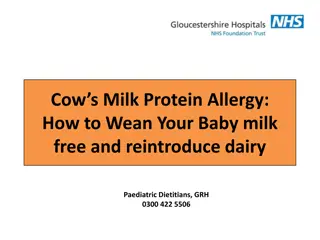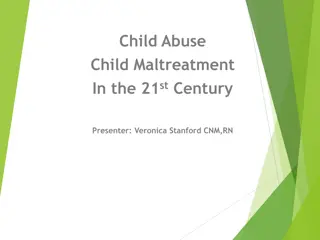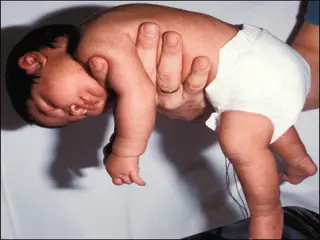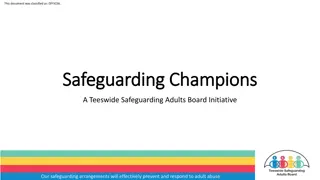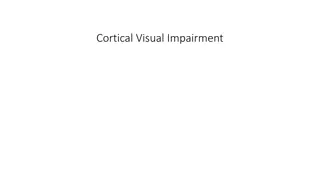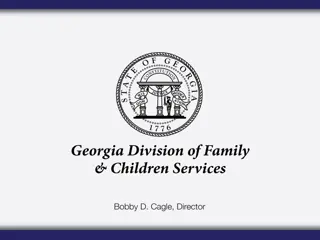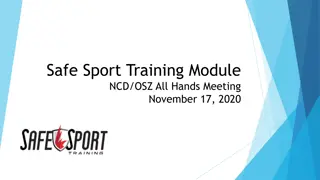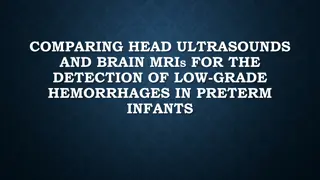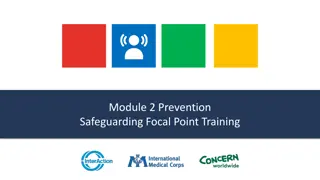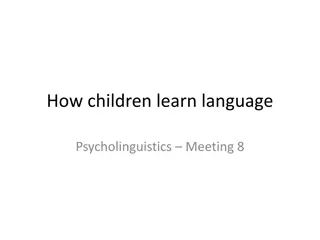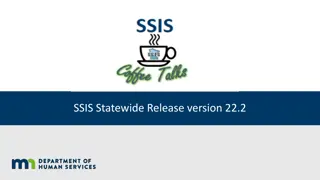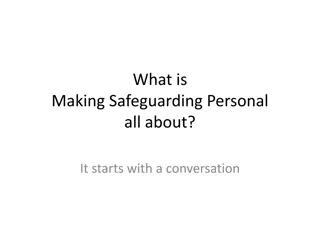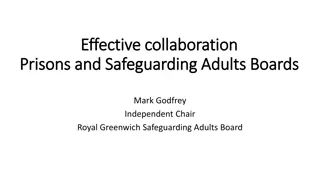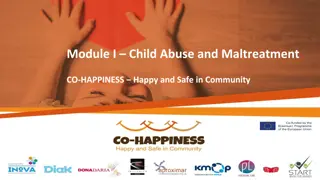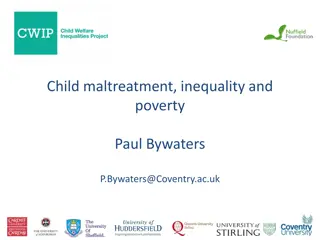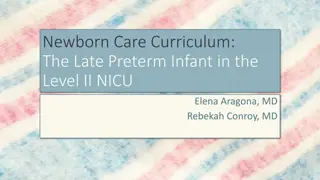Safeguarding Infants from Emotional Maltreatment: What Works?
Safeguarding infants from emotional maltreatment is crucial during the first two years of life. Emotional abuse, though not always accompanied by physical or sexual abuse, can have severe impacts on a child's development. The paper explores the structure, prevalence, and impact of emotional abuse on infants, backed by evidence-based strategies to address this critical issue.
Download Presentation

Please find below an Image/Link to download the presentation.
The content on the website is provided AS IS for your information and personal use only. It may not be sold, licensed, or shared on other websites without obtaining consent from the author. Download presentation by click this link. If you encounter any issues during the download, it is possible that the publisher has removed the file from their server.
E N D
Presentation Transcript
Safeguarding infants from Safeguarding infants from emotional maltreatment: emotional maltreatment: What works? What works? Professor Jane Barlow
Structure of paper What is emotional abuse during the first two years of life; Why the first two years matter; What the evidence tells us about what works
Emotional Abuse Emotional Abuse
Emotional Abuse Emotional Abuse the problem the problem Referrals for primary emotional abuse rose from 4,700 (13%) to 5,100 (20%) over past decade This equates to 4.7 per 10,000 children As many as 80% of children registered for physical abuse and neglect have also experienced emotional abuse
Subjective Perceptions Subjective Perceptions Large-scale population-based study (involving 2,869 adults) in the UK 6% reported - frequent and severe psychological control and domination; - psycho/physical control and domination, humiliation, attacks on self-esteem - withdrawal of their primary carer s attention/affection - antipathy, terrorising or threatening behaviours and proxy attacks
Five categories defined Five categories defined rejecting: behaviours which communicate or constitute abandonment of the child; isolating: preventing the child from participating in normal social interaction activities; terrorising: threatening the child with severe punishment, or deliberately cultivating a climate of fear or threat; ignoring: where the caregiver is psychologically unavailable to the child and fails to respond to the child's behaviour; and corrupting: caregiver behaviour which encourages the child to develop false social values that reinforce antisocial or deviant behavioural patterns (Glaser and Prior,2002)
What is emotional abuse? A constant, repeated pattern of parental behaviour, (unaccompanied by physical abuse, sexual abuse or necessarily by physical neglect) that is likely to be interpreted by a child that she or he is unloved, unwanted, serves only instrumental purposes, and/or which severely undermines children s development and socialisation (Barlow and Schrader-McMillan 2010)
Definition Definition Consistent with WHO definition (1999) Includes acts toward the child that have a high probability of causing harm to their health or to any aspect of their development (physical, emotional or social etc) ALSO includes the failure to provide a developmentally appropriate and supportive environment in which the child can develop the full range of emotional and social competencies commensuratewith her or his personal potential
Early Development and Later Wellbeing Smoking/drugs Self-esteem Parenting Promiscuity Behaviour Infants CNS School failure Mentalising Delinquency Relationships Emotional regulation via attachment Obesity Empathy Learning ETC CORE of incipient self
Trauma in infancy: attachment system compromised. Sensitised nervous system as brain adapts to emotional environment. Stress in adult: reminders & experiences of trauma, life events, etc. Unbearably painful emotional states. Self-destructive actions: substance abuse eating disorders deliberate self-harm suicidal actions Destructive actions: aggression violence rage Retreat: isolation dissociation depression
Aspects of Early Development Emotional competence Development Cognitive Social Competence Impulse control Infancy Trust/attachment Alertness/curiosity Toddlerhood Empathy Communication/ mastery motivation Coping Childhood Social Relationships Reasoning/problem solving Goal-directed behaviour Adolescence Supportive social network Learning ability/achievement Social responsibility
The Social Baby In first 15 hours baby s distinguish the voice, smell and face of their mother They connect what they do with what happens immediately after Babies have a sophisticated understanding of facial expressions distinguish between surprise, fear, sadness, anger and delight By 10- months babies seek emotional information from others to help them interpret things around them By 10-months baby s brain has developed according to the type of emotions to which they have been exposed (Beebe and Lachman, 2004)
Affect synchrony Mirroring Parent-Child Interaction Containment Reflective function Infant secure Attachment i. Attachment behaviours ii. Internal Working Model Sense of self
Affect Synchrony the dance By two months the mothers face is the primary source of visuo-affective communication Face-to-face interactions emerge which are high arousing, affect-laden and expose infants to high levels of cognitive and social information and stimulation To regulate this infant and mothers regulate the intensity of these interactions affect synchrony and repairs to ruptures Absolutely fundamental to healthy emotional development prolonged negative states are toxic to infants Adults that are incapable of attunement i.e. intrusive; depressed, cannot regulate appropriately
Attuned mutual co-ordination between mother and infant occurs when the infant s squeal of delight is matched by the mother s excited clapping and sparkling eyes. The baby then becomes overstimulated, arches its back and looks away from the mother. A disruption has occurred and there is a misco-ordination: the mother, still excited, is leaning forward, while the baby, now serious, pulls away. However, the mother then picks up the cue and begins the repair: she stops laughing and, with a little sigh, quietens down. The baby comes back and makes eye contact again. Mother and baby gently smile. They are back in sync again, in attunement with each other (Fosha, 2003 in Walker 2008, p. 6).
Reflective Function Capacity to understand the infant s behaviour in terms of internal states/feelings A key determinant of self-organization which is acquired in the context of the child's early social relationships (Fonagy, 1997) Development of self-organization is dependent on the caregiver's ability to communicate understanding of the child's intentional stance via marked mirroring Lack of parental RF plays a key role in pathological functioning
Affect synchrony in the face of parental problems Infant s emotional states can trigger profound discomfort in the parent (e.g. where there is unresolved loss/trauma, mental health problems, drug/alcohol abuse, or where there is domestic violence etc) Interaction becomes characterized by withdrawal, distancing or neglect (i.e. omission) or intrusion in the form of blaming, shaming, punishing and attacking (i.e. commission) (ibid).
The Impact on the Developing Neurosystem
The Infants Brain Softwiring Unique wiring of individual brain determines how we behave; think; feel; memories etc and our sense of self Wiring takes place during prenatal period to school-entry important first two years Rapid proliferation and overproduction of synapses followed by loss (pruning) Use it or lose it lost if not functionally confirmed Influenced by genes and environment Most important aspect of the environment is primary care-taker
For example Looks and smiles help the brain to grow Baby looks at mother; sees dilated pupils (evidence that sympathetic nervous system aroused and happy); own nervous system is aroused - heart rate increases Lead to a biochemical response - pleasure neuropeptides (betaendorphin and dopamine) released into brain and helps neurons grow Families doting looks help brain to grow Negative looks trigger a different biochemical response (cortisol) stops these hormones and related growth (Gerhardt, 2004)
Babies of depressed mothers: - nearly half show reduced brain activity - much lower levels of left frontal brain activity (joy; interest; anger) Early experiences of persistent neglect and trauma: - overdevelopment of neurophysiology of brainstem and midbrain (anxiety; impulsivity; poor affect regulation, hyperactivity) - deficits in cortical functions (problem-solving) and limbic function (empathy)
Attachment Attachment What is it:? - Affective bond between infant and caregiver (Bowlby, 1969) What is its function?: - Dyadic regulation of infant emotion and arousal (Sroufe, 1996) Antecedants of attachment: Sensitive, emotionally responsive care during first year secure attachment Insensitive, inconsistent or unresponsive care insecure attachment
The Importance of The Importance of Attachment Attachment Secure base to explore the world Prototype for later relations internal working model is a representational model of self and self with other Provide child with expectations in relation to self and others
Attachment Attachment Majority of children (two thirds) who have sensitive care will form secure attachments 67% Remaining children will be: - Insecure attachment (i.e. unable to use caregiver to modulate their aroused state) Avoidant over-regulate; Resistant under-regulate - Disorganised attachment no consistent patterns of behaviour - conflicting emotions E.g. 82% of abused cf 19% of non-abused children had disorganised attachment (Carlson, Cicchetti et al., 1989)
Disorganised/Controlling Attachment 82% of abused cf 19% of non-abused children had disorganised attachment (Carlson, Cicchetti et al., 1989) Caregivers unpredictable and rejecting; source of comfort also source of distress Self represented as unlovable, unworthy, capable of causing others to become angry, violent and uncaring Others frightening, dangerous, unavailable Predominant feelings fear and anger Little time for exploration or social learning
Arousal following trauma Hyper-arousal (aggression, impulsive behaviour, children emotional and behavioural problems Fight or flight response) Window Of Tolerance Hypo-arousal (dissociation, depression, self harm etc)
Compulsive Strategies Compulsive compliance (where parent is threatening) watchful; vigilant and compliant Compulsive caregiving (where parent is needy) role reversal; parentification; children deny own developmental needs Coercive combination of threatening and placatory behaviours Controlling strategies (abusive and neglectful) self is strong and powerful but also dangerous and bad; avoidance and aggression; completely out of control and fearless
Compulsive caregiving Caroline is 18 months old. She lives with her mother, who is chronically depressed. The mother describes the household as noxious to the soul . She cannot tolerate the idea that her depression is affecting Caroline. She says: Caroline is the only one who makes me laugh. It is observed that Caroline silently enacts the role of a clown. She disappears into her room and comes out wearing increasingly more preposterous costumes. Caroline makes her mother laugh, but she herself never laughs (Howe, 1999)
Disorganised attachment stems from disruption in the emotional communication, or lack of attunement, between parent and baby. A withdrawing response.. Borderline symptoms in late adolescence. Strongest predictor Negative-intrusive responses.. Lack of effective regulation of fearful arousal in infant. (Disorganised attachment.) Hostile / frightening response. A role-confused response. Disoriented/confused responses. Dissociative symptoms in late adolescence. Emotional communication errors, e.g. giving conflicting cues to baby, failure to respond to infant s signals.
Framework Prevention before occurrence Prevention of recurrence Prevention of impairment Physical abuse Sexual abuse Emotional abuse Neglect Witnessing IPV Long-term outcomes Universal Targeted
Prevention before occurrence
Nurse Family Partnership Intensive home visits during pregnancy and first two years Goal based; ecological; attachment; self-efficacy etc Reduced child physical abuse and neglect, as measured by official child protection reports Reduced associated outcomes such as injuries in children of first-time, disadvantaged mothers Level of evidence: RCTs
Triple P Dissemination of Triple P professional training to the existing workforce alongside universal media and communication strategies, across 18 randomly assigned counties in the US Showed positive effects on substantiated child protection services reports, out-of-home placements, and hospital and emergency reports of injuries Rates of maltreatment rose in both groups Analysis is not clear, and further evaluation and replication is recommended Level of evidence: one RCT
Healthy Child Programme Preparation for parenthood Supporting bonding Supporting attachment and addressing early problems Supporting parenting Identifying and supporting high-risk families teenage parents; domestic violence; parental mental health problems
Preventing re-exposure and impairment
Key Intervention Approaches Sensitivity/attachment-based: Interaction Guidance; FNP Psychotherapeutic: Parent-infant psychotherapy Mentalisation: Minding the Baby Parenting programmes Parents under Pressure Parenting Programmes Circle of Security; Baby Triple P
Nurse Family Partnership Intensive home visits during pregnancy and first two years Goal based; ecological; attachment; self-efficacy etc Reduced child physical abuse and neglect, as measured by official child protection reports Reduced associated outcomes such as injuries in children of first-time, disadvantaged mothers Level of evidence: RCTs
Interaction guidance Interaction guidance Weekly for 10 weeks - reinforcement of adequate maternal behaviours; modification of inappropriate patterns; Video based recordings and coaching of actual interactions 22 FTT mothers and babies - significant reduction decreasing atypical behaviours and disrupted communication (Benoit et al 2001) [Tissot et al., 1999]
PUP Programme PUP is underpinned by an ecological model of child development and targets multiple domains of family functioning, including the psychological functioning of individuals in the family, parent child relationships, and social contextual factors. Incorporates mindfulness skills that are aimed at improving parental affect regulation; PUP comprises an intensive, manualized, home-based intervention of ten modules conducted in the family home over 10 to 12 weeks, each session lasting between one and two hours
PUP evaluation Parents Under Pressure RCT with substance abusing parents of children aged 2-8 years (Dawe and Harnett 2007) Compared PUP with standard parenting programme Significant reductions in parental stress; methadone dose and child abuse potential (significant worsening in the child abuse potential of parents receiving standard care); improved child behaviour problems
Mentalisation Mentalisation- -based approaches approaches based Emerging model of intervention that builds on both parent-infant psychotherapy and recent advances in advances in attachment theory Minding the Baby is an interdisciplinary, relationship based home visiting program for young, at-risk new mothers Delivered by a team that includes a nurse practitioner and clinical social worker- uses a mentalisation-based approach that involves working with mothers and babies in a variety of ways to develop mothers' reflective capacities It aims at addressing relationship disruptions that stem from mothers' early trauma and derailed attachment history Only case-study evidence available (Slade et al., 2005)
Parent-Infant Psychotherapy Focus on mother s representational world e.g. the way in which the mother s current view of her infant is affected by representations from her own history Fraiberg Ghosts in the Nursery Linking of ghosts with mother s own history facilitates changes to her representational world and new paths for growth of both mother and infant
Combined Approaches Watch, Wait and Wonder Infant led parent-infant psychotherapy Mother observes her infant s self-initiated activity whilst being physically accessible to infant Discussion of these experiences with therapist as a way of examining the mother s internal working models of herself in relation to her infant


